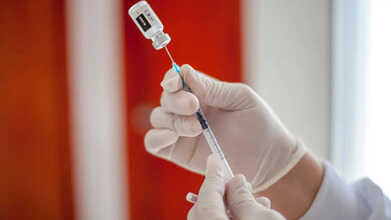- Health Conditions A-Z
- Health & Wellness
- Nutrition
- Fitness
- Health News
- Ayurveda
- Videos
- Medicine A-Z
- Parenting
- Web Stories
This FDA-Approved Drug Combo Could Reduce Risk Of Prostate Cancer Deaths By 40%

(Credit-Canva)
Prostate cancer is one of the most common cancers in men. About 1 in 8 men are at risk of prostate cancer diagnosis and about 1 in 44 men die due to it, according to the American Cancer Society. While the rates of deaths related to prostate cancer have declined in recent years, this decline rate has slowed down, meaning that more cancers are being detected at an advanced stage.
However, a new clinical trial could help turn these statistics around. This is not a new medicine, this treatment regime is based on two FDA-approved drugs, and it is showing some promising results.
A new clinical trial shows that a combination of two drugs can dramatically help men whose prostate cancer has returned following surgery or radiation. This new therapy was found to cut the risk of death by more than 40% in this high-risk group.
The successful regimen combines the drug enzalutamide with the standard hormone therapy doctors typically prescribe. This dual approach resulted in a major reduction in deaths for patients with recurrent prostate cancer who previously had very few effective treatment options left.
The highly anticipated results were published in The New England Journal of Medicine (NEJM) and presented simultaneously at the European Society for Medical Oncology Congress (ESMO) on October 19.
Why Is Prostate Cancer Considered High Risk?
The American Cancer Society estimates for 2025 are about 313,780 new cases of prostate cancer diagnosis and 35,770 deaths from it. One of the best ways to combat cancer is early diagnosis, however, missing symptoms is very easy. With the help of this medicinal regime, many people can avoid facing harsh cancer treatments.
The clinical trial was extensive, involving over 1,000 patients from hundreds of medical facilities across 17 different countries. All of the men were diagnosed with a condition known as high-risk biochemically recurrent prostate cancer.
This specific diagnosis is given to men whose blood levels of a protein called PSA (Prostate Specific Antigen) suddenly start to climb rapidly after they've had surgery or radiation. Doctors use the PSA protein to track the cancer, and a quick rise is a strong signal that the cancer is highly likely to come back and spread to other areas, most often the bones or spine. Without a truly powerful treatment, these patients face a high risk of developing widespread cancer and possibly dying from their disease.
What Medicine Can Reduce the Risk Of Prostate Cancer?
In the study, the men were randomly put into three groups: one group got only the standard hormone therapy, one got only enzalutamide, and the third got the combination of both drugs. After the men were tracked for eight years, the group that received the combination treatment had a death rate that was 40.3% lower than the other two groups.
These excellent results are expected to quickly change the way doctors treat this type of cancer everywhere. The drug enzalutamide is already approved by government agencies and listed in major cancer treatment guidelines based on previous studies.
These latest results will likely make the recommendation even stronger, confirming that this drug combination should become the standard treatment for men with this aggressive, recurrent prostate cancer. This outcome supports earlier research and will significantly improve how doctors care for their patients.
Symptoms of Prostate Cancer You Should Know.
While researchers are working on ways to improve prostate cancer treatment, one must know how to spot any symptoms of it as well. According to the National Health Service UK, prostate cancer has no symptoms at first. However, as the cancer starts growing on the outer parts of the prostate, you may notice some problems.
- Having a hard time getting your urine flow to start, or needing to push or strain to get the urine out.
- When you do urinate, the flow is much weaker than usual.
- Your stream stops and starts multiple times while you're trying to empty your bladder.
- Suddenly seeing a rise in the urgency and frequency of needing to urinate, than what you usually feel.
- Feeling like your bladder isn't completely empty, even right after you finish urinating.
- Waking up many times during the night because you need to urinate.
Some symptoms of advanced prostate cancer include
- Erectile dysfunction
- Blood in your urine or semen
- Lower back pain and unexpected weight loss.
This Is The Age Your Brain Performs The Best: Study Reveals Brain Reaches Its Best Years Later Than We Think

(Credit-Canva)
Our bodies may hit their peak strength, skin firmness, and ability to have children when we are young adults, but new studies have found that our brains actually perform their best much later in life.
As people get old, the perception that they are no longer capable of making decisions or that they stop remembering things becomes rampant. These assumptions can lead to age-based discrimination, such as favoring younger employees over older, experienced ones. However, how true is this assumption? Do we actually start experiencing cognitive decline as soon as we come close to midlife?
A study published in the journal Intelligence looked at data measuring abilities like reasoning, memory, processing speed, general knowledge, and emotional intelligence across different ages.
What Age Are We Best Mentally?
The findings challenge the idea that we’re mentally sharpest in our 20s. Instead, the research found that our overall psychological functioning peaks much later, typically between ages 55 and 60.
According to the lead study author, our mental ability doesn't really start to drop until around age 65, and the decline only gets noticeably faster after age 75.
The research also looked closely at five main personality traits: being outgoing, handling stress well, being careful and organized, being open to new things, and being agreeable.
How Does Our Personality Affect Our Brain Health?
The researchers discovered that many of these traits also reach their best levels later in life. For example, conscientiousness (being thorough and disciplined) peaks around age 65, and emotional stability (staying calm and balanced) is highest around age 75.
The study further found that our ability to make good moral judgments improves with age, and our skill at making rational decisions (resisting poor cognitive biases) may continue to improve even into our 70s and 80s. This helps explain why many top jobs in business and government are often held by people in their 50s and early 60s.
What Role Does Age Play In Real World?
This latest research focused on real, measurable psychological strengths that directly lead to better performance in the real world. Many of these strengths, like better judgment and decision-making, are vital for people in leadership positions.
However, despite these clear signs that older people are at their psychological peak, they still often face major challenges when looking for a new job or trying to stay in their current one.
Even though there is a law (the Age Discrimination in Employment Act of 1967) that protects people aged 40 and over from unfair treatment in hiring and firing, discrimination still happens in reality. An Ageism in the Workplace Survey found that a huge 90% of workers over age 40 have experienced ageism at work. Many employers wrongly believe that someone in their mid-50s is a poor long-term investment.
The hope is that these new findings will make it clear that companies need to adopt fair hiring and retention practices that include older workers. As the author noted, history is full of people who achieved their biggest successes well past the age society usually labels as the "peak."
Who Is Eligible For The RSV Vaccine This Respiratory Virus Season?

Credits: Canva
Respiratory virus season is upon the United States as colder months arrive, bringing an expected rise in cases of COVID-19, influenza, and RSV. In its annual outlook, the Centers for Disease Control and Prevention (CDC) predicts that peak hospitalizations from these viruses during the 2025–26 season will be similar to last year. Public health experts speaking to ABC News have emphasised that vaccination remains the most effective way to protect against severe illness. Below, we answer common questions about the RSV vaccine for anyone seeking guidance.
What Is The RSV Vaccine?
The RSV vaccine is a shot designed to protect against respiratory syncytial virus (RSV), which can cause serious lung infections in infants and older adults. Vaccines work by prompting the body to create antibodies that help fight off the virus. There are several types of RSV vaccines, including mRNA and protein-based versions, each working in slightly different ways to stimulate the immune system.Who Can Get An RSV Immunization?
According to the CDC, RSV vaccines are recommended for adults aged 75 and older, as well as those between 50 and 74 who have a higher risk of severe illness. Studies suggest that a single dose provides protection for at least two years in older adults. For infants, protection can be achieved either by vaccinating mothers during pregnancy or by giving babies an antibody shot after birth to help prevent severe RSV infection.
When Is The RSV Vaccine Available?
Eligible adults can receive the RSV vaccine at any time, though late summer and early fall are generally considered the best period, according to the CDC. For expectant mothers, the vaccine is usually available between September and January, while the antibody shot for infants is typically recommended from October through March.
How Much Does The RSV Vaccine Cost?
For those with insurance, the RSV vaccine may be fully covered. Without insurance, the shot can cost around $350, according to Dupont. “Patient assistance programs are available that can significantly reduce out-of-pocket costs,” Dupont added.
Does RSV Vaccine Have Any Side Effect?
Like all vaccines, the RSV shot can have side effects. Common ones include pain, redness, or swelling at the injection site, as well as fever, headache, fatigue, and muscle or joint aches. Serious side effects are rare but can occur. Fainting may also happen after the shot, and observation may be advised to prevent injury.
Common side effects
- Pain, redness, or swelling at the injection site
- Fever
- Fatigue
- Headache
- Muscle or joint pain
- Nausea or vomiting
- Diarrhea
- Swelling or tenderness under the arm
- Rare but serious risks
- Severe allergic reaction (anaphylaxis): Symptoms may include hives, facial or throat swelling, difficulty breathing, rapid heartbeat, or dizziness. This is a medical emergency; call emergency services immediately.
- Guillain-Barré Syndrome (GBS): A very rare condition where the immune system attacks the nerves. Seek medical attention if you experience sudden weakness, tingling in the hands or feet, or pain.
- Fainting: This can occur after vaccination, and you may be asked to stay for a short observation period to prevent injury.
THIS Is The Age Sperm Quality Starts Declining: Study Reveals Age When Risk Of Passing Down Mutations Increases

(Credit-Canva)
Many people are choosing to become parents later in their lives. Whether it is due to financial reasons or due to difficulty conceiving, etc. However, many people bring up the ‘biological clock’ argument. While it is possible to have pregnancy later in life, there are some health implications, not just for the mother, but also for the child. Many people often place this responsibility on women. However, a new study shows that fathers who have children later in life may also risk passing down harmful mutations.
New research shows that as men get older, their sperm collects harmful mutations, which can raise the risk of health issues in their children.
Researchers in the UK studied sperm samples from 81 healthy men, ranging in age from 24 to 75. Using a highly accurate testing method, the team found that harmful changes, or mutations, build up in sperm over time. Simply put, the older a man is, the more his sperm’s genetic quality declines.
How Does Old Sperm Affect Offspring's Health?
The study identified over 40 genes that cause the sperm stem cells to mutate. This genetic process is known as "selfish sperm."
What's most alarming is that these harmful mutations don't just accumulate; they are actually favored during the creation of new sperm. This means that sperm cells carrying the mutations multiply and out-compete the healthy sperm, leading to a higher proportion of damaged cells. This process can lead to a two to three times higher risk of passing on disease-causing mutations. The study measured the percentage of sperm carrying disease-causing mutations and found a clear increase with age:
- Early 30s (26–42 years): About 2% of sperm carried disease-causing mutations.
- Middle-Aged and Older (43–74 years): This percentage rises significantly to between 3% and 5%.
- The overall rate of accumulation was calculated to be about 1.67 new mutations every year.
- The research specifically suggests that the genetic quality of a man's sperm starts to decline noticeably around age 43.
How Does Late Parenthood Affect Children?
These mutated genes are linked to developmental disorders and inherited syndromes that can increase the risk of certain cancers. The mutations that increase most sharply as the father ages are connected to severe neurodevelopmental disorders in children, including some conditions on the autism spectrum.
The study confirmed that specific rare genetic disorders, such as Apert, Noonan, and Costello syndromes, are rooted in this “selfish sperm” phenomenon.
These findings are particularly important today because older fatherhood is becoming much more common. The number of fathers over the age of 40 nearly doubled between 1972 and 2015.
This trend concerns the given related data: a recent analysis found that fathers over 40 had a 51% greater chance of having a child diagnosed with autism compared to fathers under 30.
While these results highlight an increased risk that older fathers should be aware of, the researchers stress that more study is needed. They also point out that while the number of mutated sperm increases with age, not all of them will lead to a successful pregnancy, as some may prevent fertilization or cause miscarriage.
© 2024 Bennett, Coleman & Company Limited

